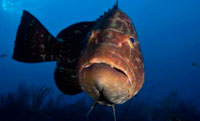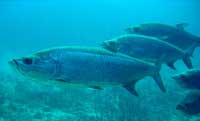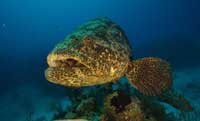It is the second largest finfish on Earth (reach 8-foot and 800-pound). Population is almost vanished from the entire Caribbean due to over harvesting and is considered Critically Endangered by IUCN. Jardines de la Reina shows the healthiest population of Goliath grouper of Cuba and the Caribbean, with weekly sightings during SCUBA diving. It is known that many large specimens left the protection of the Marine Reserve and National Park, presumably to spawn up to 100-mile away sites every summer.
Other large groupers (to 4-foot long) found in Jardines de la Reina are Black grouper (Epinephelus bonaci), Nassau grouper (Epinephelus striatus), Tiger grouper (Mycteroperca tigris) and Yellowfin grouper (Mycteroperca venenosa). All have strong, stout bodies and large mouths. They solitary carnivores that live lurking in the shadows of reefs, ledges and wrecks to ambush fish and crustaceans, drawn into their gullets by the powerful suction created when they open their large mouth. Their population has declined throughout their range: Nassau grouper is Endangered, Black grouper is Vulnerable. Jardines de la Reina shows the highest abundance and largest sizes of these species in Cuba and perhaps of the Caribbean
Cubera snapper (Lutjanus cyanopterus):

It is the largest snapper in the Western hemisphere reaching 5-foot and more than 100-pound. Cubera snapper is a nocturnal predator that feed on fish and crustaceans. During day time it tends to be solitary (mainly large specimens) or forming small schools (mainly medium size individuals). Jardines de la Reina shows the highest abundance and largest sizes of Cubera snapper in Cuba and perhaps of the Caribbean. It is considered Vulnerable by IUCN.
Gamefish:

Jardines de la Reina is one of the best shallow water fly fishing destinations on Earth. Main species target by anglers are bonefish (Albula vulpes), tarpon (Megalops atlanticus), permit (Trachinotus falcatus) and snook (Centropomus undecimalis), which together show the highest abundance of gamefish in Cuba and probably in the Caribbean islands. Bonefish likes shallow waters (sand, mud, limestone, vegetated and reef bottoms). Old adults are solitary but younger adult and juvenile group on large schools of hundreds individuals.
Bonefish feed mainly on crustaceans. It may reach 1 m and weight 10 kg and lives 19 years. Avalon Tagging Program has revealed that bonefish may travel up to 37 nautical miles in few months. It is considered Vulnerable by IUCN. Tarpon is considered the king of gamefishing due to its size (2.5 m), weight (160 kg) and strength (allow them to jump acrobatically out of the water). It lives in coastal and oceanic waters but prefer coastal ones. Tarpon may live more than 70 years and female produce up to 20 million eggs. It feeds mainly and fish and crustaceans.
Permit behavior, shape and strength make its catch very challenging. It is mainly a coastal species, seen solitary or in small schools on sandy or sand-mud bottoms. Permit feed mainly in crustaceans. Juvenile are abundant in Jardines de la Reina beaches during summer. It may reach 120 cm and 36 kg. Snook is found on lower salinity waters. It is a relatively sedentary and generally solitary species. Snook feed on fish and crustaceans. It may reach 1.3 m.
Sharks (Orders Orectolobiformes (Carpet sharks), Lamniformes (Mackerel sharks) y Carcharhiniformes (Ground sharks)):

Sharks are critical to marine environment due to their ecological role as top predators, maintaining ecosystems health and equilibrium. Increase fishing pressure and value to tourism make important their conservation and sustainable management. The Orders mentioned above include about 40 species reported for Cuban waters and potentially found in Jardines de la Reina. Of the 10 species reported in Jardines de la Reina, 6 are considered Vulnerable by IUCN.
The list include: Rhincodon typus (Whale shark, the largest fish exited ever), Ginglymostoma cirratum (Nurse shark), Carcharhinus brevipinna (Spinner shark), C. falciformis (Silky shark), C. perezii (Caribbean reef shark), Negaprion brevirostris (Lemon shark), Rhizoprionodon porosus/terranovae (Caribbean/Atlantic Sharpnose sharks), Sphyrna mokarran (Great Hammerhead), C. limbatus (Blacktip shark), Galeocerdo cuvier (Tigre shark). Jardines de la Reina is one of the few places in the Caribbean where sharks can be observed everyday, mainly Nurse, Silky, Caribbean reef and Lemon sharks.
Eagle ray (Aetobatus narinari):

It is one the “flying” rays since it spends most of its time swimming. As other rays, Eagle ray has greatly enlarged pectoral fins (to 8-foot from tip to tip), providing it propulsion for swimming much like birds use their wings for flight. Adult Eagle rays are often spotted on reef crest and channels of Jardines de la Reina, while juveniles roamed in flats. This species jumps acrobatically out of the water giving to the observers a wonderful experience. It is considered Vulnerable by IUCN.



